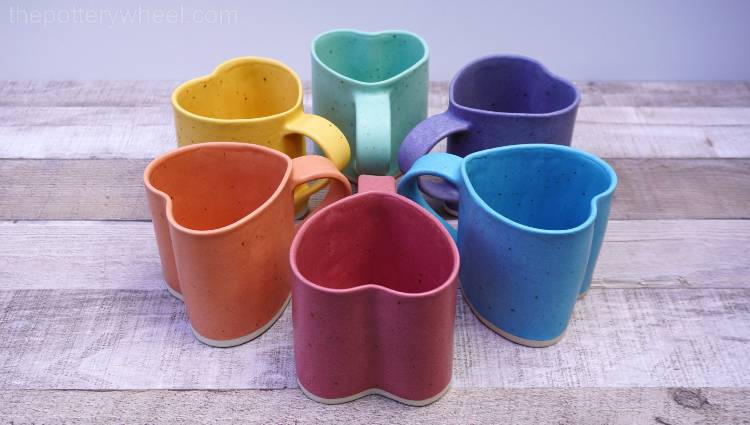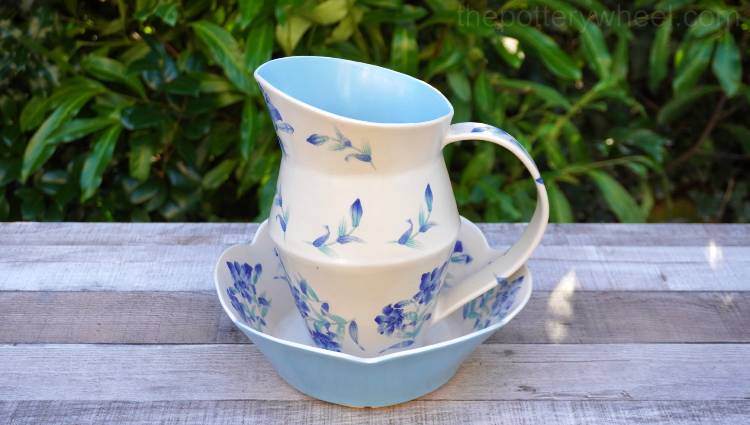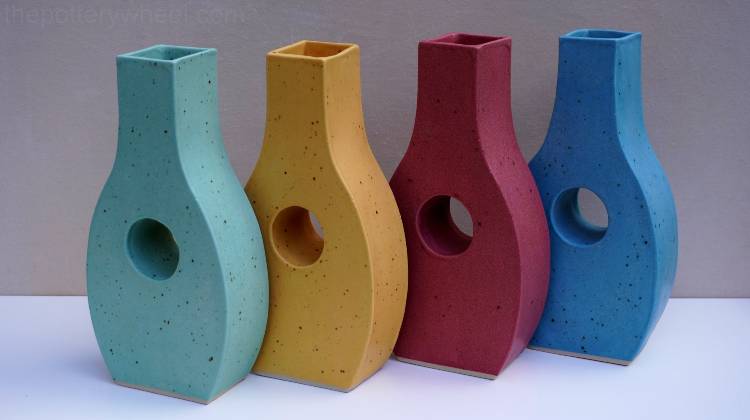Your cart is currently empty!
Can You Mix Different Types of Clay? Combining Clay
Published:
Last Updated:
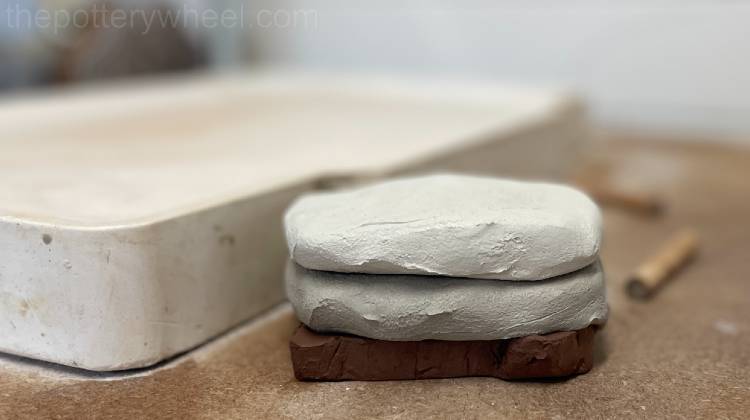
Affiliate Disclaimer
As an affiliate, we may earn a commission from qualifying purchases. We get commissions for purchases made through links on this website from Amazon and other third parties.
There are lots of different types of clay and a range of clay bodies to choose from. But, can you mix different types of clay together? Will it create a lovely clay cocktail or a clay catastrophe?
Yes, you can mix different types of clay. But, these clays must fire at a similar temperature and have a similar shrinkage rate. This helps avoid problems when drying and firing the clay.
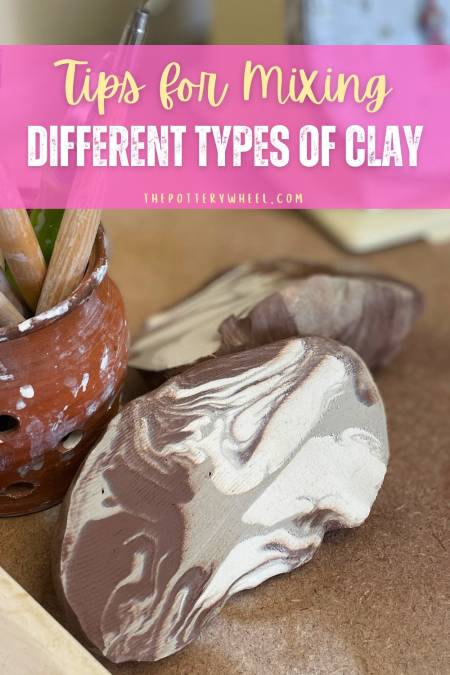
Why Mix Different Types of Clay Together?
Here are some reasons why you might want to mix different types of clay together:
- Using up left over clay scraps
- Combining the properties of two or more clay bodies
- Creating a particular effect such as marbling or joining two types of clay
Alternatively, you may just be worried about one type of pottery clay contaminating another. If, like me you have a small pottery workspace, you may find yourself using the same tools and equipment for different clay bodies. For example, I have one wedging table that I use for different types of clay.
Although I keep my pottery space clean and tidy to keep clay dust to a minimum, there are times when small amounts of one clay body will get mixed up accidentally with another. The question is, is this a problem? Let’s look at that now…
Pottery Clay is Already a Mixture
The clay that you buy from a pottery supplier is made up of different ingredients, and will often be a blend of different types of clay. For example, it might contain ball clay, fire clay, and kaolin.
Each of these different ingredients gives the clay different properties. So, different types of clay have already been mixed up in one clay body.
If you have a quick browse online or look in a lot of pottery reference books, you can see recipes for different clay bodies that include more than one type of clay. Take a look at this clay recipe from the Ceramic Arts Network for high-fire stoneware clay (source).
- Custer Feldspar 12%
- Hawthorne Missouri Fireclay 26%
- Hawthorn Bond Fireclay 13%
- Kentucky Stone Ball Clay 13%
- OM4 Ball Clay 26%
- Virginia Kyanite 10%
Nevertheless, clay is manufactured carefully so that the properties of each clay used are compatible. If you are considering mixing different types of clay, you also need to think about their different properties. Let’s take a look at those properties now…
Tips For Mixing Different Types of Clay
Different clay bodies have unique properties and behave in different ways. For example, porcelain clay shrinks a lot when it dries and is fired at high temperatures. By contrast, earthenware usually doesn’t shrink as much and is fired at lower temperatures.
If you are mixing different types of clay these properties need to be compatible. Here are some guidelines about mixing clay for pottery.
1) Mix Clays That Fire at a Similar Temperature
One important factor to consider is the temperature the clay needs to be fired at.
If you mix clays that fire at different temperatures, one clay will mature earlier than the other. This can create problems in the kiln. If low-fire clay like terracotta is fired at high-fire temperatures, it can crack, shatter, or melt.
So, mixing a high-fire clay like porcelain with earthenware clay and then firing it at high fire temperatures is probably going to cause problems. If you fire at lower temperatures so that the earthenware survives, your porcelain won’t have matured.
But equally, if you fire it at higher temperatures so that the porcelain matures, your pots may shatter or melt.
However, if you mix two types of clay that mature in the same temperature range, then you are less likely to have issues.
For example, some stoneware and porcelain bodies have similar properties and can be fired at the same temperature. As a result, you are less likely to have problems if you mix porcelain and stoneware clay.
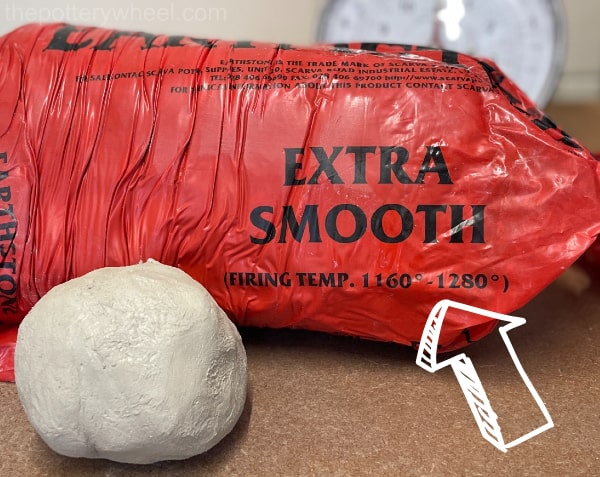
Silica
Another related issue is the size and amount of silica in the clay body. Silica is the glass-forming ingredient in the clay that melts when it is fired.
Different clays have silica granules of varying sizes. The size of the silica affects how much of it changes to glass when it is fired.
This affects how porous the clay is and what the clay looks like when it’s fired. But it also affects how much the clay expands and contracts when it is fired. This is called thermal expansion (source).
If you blend two clays that expand and contract at different rates when fired, you may encounter problems when the clay is fired. This is because the different rates of expansion will put the pottery under stress when it’s being fired.
2) Mix Clays That Have a Similar Shrinkage Rate
It is also important that clay bodies shrink at the same rate. If one clay shrinks more, or faster than the other, it can break apart when they are drying or being fired. Or, if they don’t separate, it can put the pottery under stress, which will affect its strength and integrity.
You can find the shrinkage rate of a pre-made clay body in the manufacturer’s specifications. This may be printed on the clay bag, or it will likely be in the details on the supplier’s website. Clay normally shrinks somewhere between 10 and 20%. This can help you combine clays that shrink at a similar rate.
3) Mix Clays That Have Similar Moisture Content
Clay with a higher moisture content will shrink more than clay with less moisture. If you bond clay bodies together that have different moisture content, it’s more likely to crack and separate when it dries.
But this does depend on how you are combining your clay. If you are blending it to make one clay body, then this will distribute the moisture evenly.
However, if you are partially blending it, to create a marbled effect, then the uneven moisture content might cause problems.
Ways to Mix Different Types of Clay
Here are some of the ways that clay bodies can be mixed together.
1) Breaking The Rules
Some ceramic artists live to break the rules, and Ewen Henderson was one of them. Henderson was a ceramicist and sculptor who hand-built his work, often using coiling and pinching techniques.
He would combine different colored clays, and different clay bodies in pots and sculptures. His mixed clay pottery often had a geological look about it.
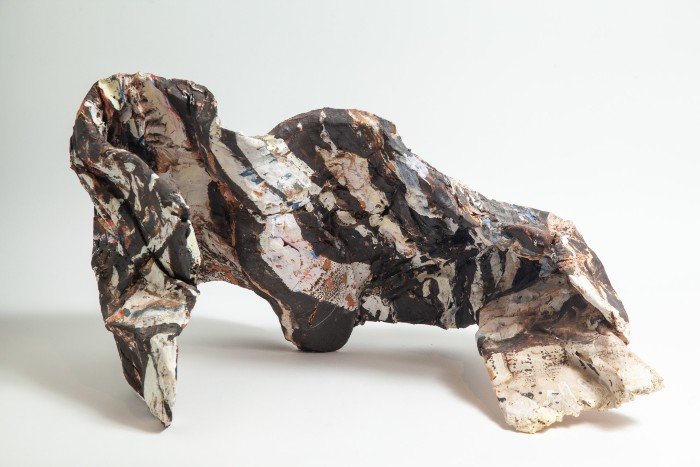
photo © Philip Sayer courtesy of Marsden Woo, London
2) Blending Clay
Another way to mix your clay is to blend more than one clay body to make a new clay with its own properties.
Some potters will make their own clay recipes using blends of powdered clay and mixing them together with water to make a unique clay body.
Or you can combine two types of clay bodies that are already in a workable moist state. One way to do this is to wedge the clay together until they are completely blended.
A satisfying way of doing this is to use the stack and slam or wire wedging technique. With slam wedging, you stack the different clays on top of one another and slam them onto your worktop. Then slice them in two, stack them again, and slam them on the worktop.
Using this technique, you end up with a block of clay that has layers of different types of clay mixed together. As you wedge, the different layers of clay get thinner and thinner, until the clays are completely mixed together.
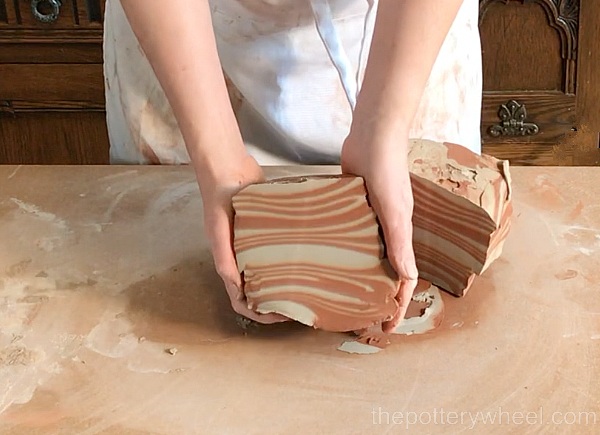
You can read my step-by-step guide on stack and slam wedging here.
3) Mixing Dry Clay
Another option is to mix clay in its dry-powered form. You can often buy a particular clay body in its moist form, or you can buy it in the form of a dry powder that needs to be mixed with water.
The advantage of mixing different types of clay when they are in their dry powdered form is that it’s easier to mix the two clay bodies together thoroughly. Wedging moist clay together is quite labor intensive.
If you are mixing clay on a large scale, it might make sense to get a mechanical clay mixer. But these are large pieces of kit and very expensive.
If you are mixing smaller batches of dry clay, you can simply mix your clay bodies together and add some water. Blend the clay with the water using a paint-mixing drill bit. This will create a clay slurry.
The wet slurry can then be poured onto a plaster drying slab. This will draw out excess water from the clay mixture. When the mixed clay is firm enough, it can be wedged to remove any air pockets.
4) Agateware
When you are mixing clay together, you can blend them completely. Or, you can stop short of completely mixing them together.
By doing this you will have a piece of clay with visible layers of contrasting colors. This can create a beautiful marbling effect in your pottery. This is the principle behind agateware pottery.
In Agateware, different colored clay bodies that are compatible with each other can be combined together. This pitcher was made using a mixture of brown and cream-colored earthenware.
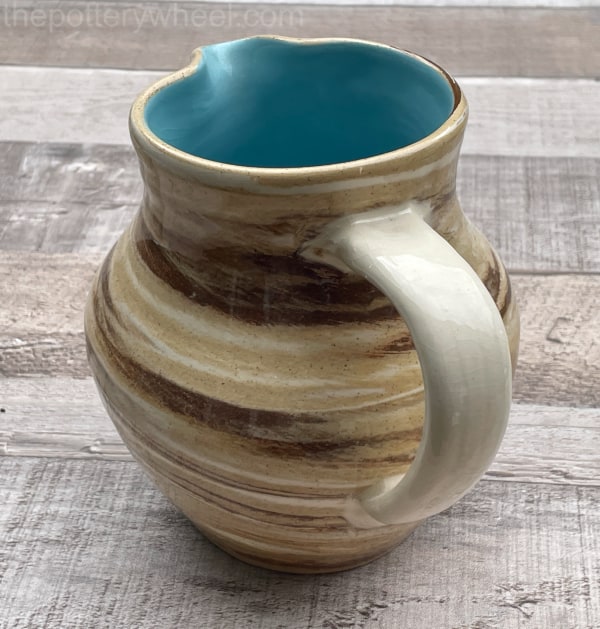
Or, the same clay body can be stained with ceramic stains or oxides, to create different colored clay. For example, I added colored ceramic stains to several batches of cream-colored stoneware clay and slab built this marbled mug.
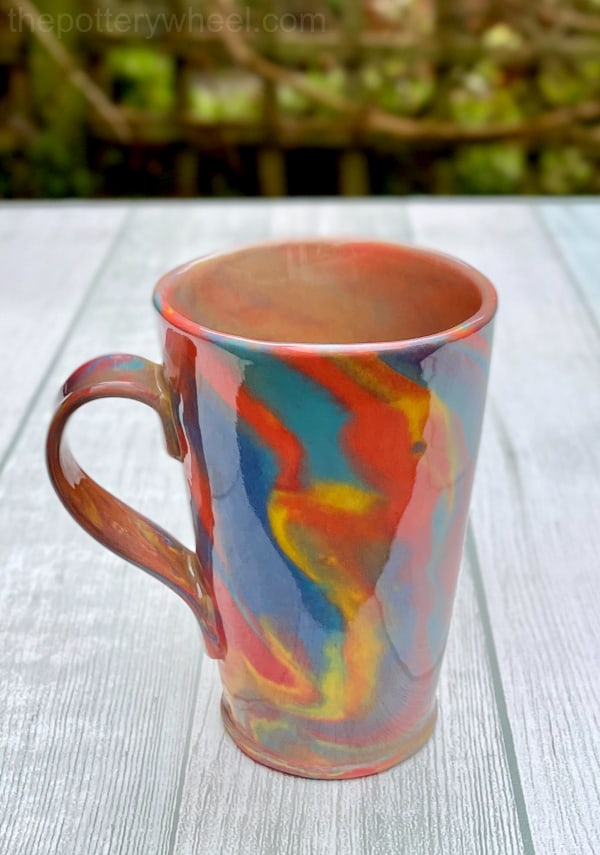
Different colored clay can be thrown on the wheel or can be constructed using hand-building techniques like slab pottery. The different colored clays from swirls and streaks on the pot that give it the marbled effect.
Final Thoughts
Mixing different types of clay together can be an experiment. It’s a good idea to be prepared for things to not work out quite how you intended. If you want to mix two clay bodies, it’s a good idea to make some test tiles first. Fire them and glaze them to see how they get on with each other, and also to check that they get on well with your glaze once they have been mixed together.
Also, remember that you can buy hybrid clays from many suppliers. For example, you can buy clay which is a mixture of porcelain and stoneware, which has a blend of their best properties. It’s sometimes called porcelaneous stoneware.

